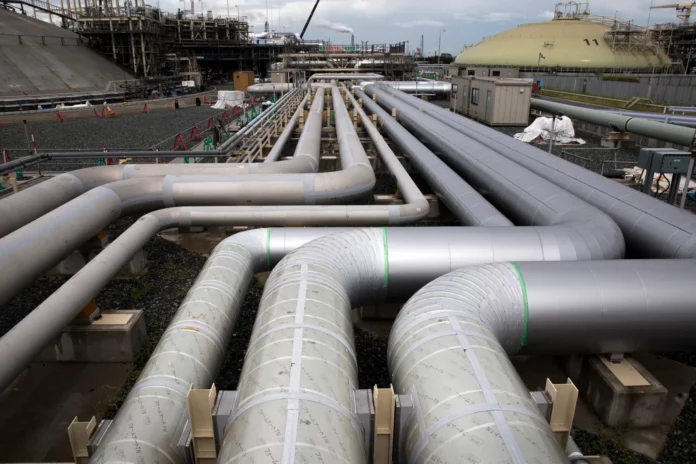[SINGAPORE] Asian energy buyers are rethinking their long-term bets on US liquefied natural gas (LNG) – increasingly seen as a geopolitical lever – as tariffs, political risk and volatile costs cloud the appeal of the US as a reliable trading partner. Experts say this shift could open the door to rival exporters, as Asia moves to diversify its supply sources.
Underscoring this is a once-flagship US$44 billion Alaska LNG project – revived under US President Donald Trump and pitched as a fast-track export route to Asia – which is struggling to secure regional backing, despite being used as a bargaining chip during the 90-day tariff pause since Apr 9.
While reports indicate that US’ allies such as Japan and South Korea have expressed interest in participating in the project, no financial commitments have yet been made by any Asian buyer. This underscores broader hesitancy amid Washington’s protectionist turn and rising infrastructure costs, experts say.
Industry players have also long questioned the project’s profitability. At an earnings briefing this month, Daisuke Yamada, senior managing executive officer at Japan’s oil major Inpex, said the Alaska LNG project is “extremely difficult to make profitable”, noting that construction on frozen terrain is limited to only parts of the year.
A NEWSLETTER FOR YOU
Friday, 8.30 am
Asean Business
Business insights centering on South-east Asia’s fast-growing economies.
The proposed project – a 1,300 km natural gas pipeline stretching from the North Slope to Nikiski – aims to commercialise natural gas reserves discovered in 1969. Since its inception, the project has been targeting Asian buyers with its Nikiski terminal offering faster shipping access to Japan, South Korea, Taiwan and South-east Asia.
Source diversification
In 2024, the US accounted for over 10 per cent of total LNG imports in Japan, South Korea and Taiwan, making it the region’s third-largest supplier.
In March, Taiwan’s state-owned CPC Corporation signed a non-binding letter of intent to purchase six million tonnes annually from Alaska LNG – more than its total LNG imports from the Middle East (Qatar, United Arab Emirates, Oman) – in a bid to strengthen ties with the Trump administration.
One observer described Taiwan’s LNG deal with Alaska as a political rather than economic move, noting that the island already imports substantial volumes from Qatar – one of its top suppliers and a global leader in low-cost production.
According to a Reuters report citing a source, Trump’s energy security council plans to host a summit in Alaska in early June, when it hopes to secure commitments from Japan and South Korea for the Alaska LNG project.
With the Alaskan project likely to yield more expensive LNG, Asian buyers are shifting towards a diversified sourcing strategy to meet growing demand.
Gupta expects a diverse range of LNG sources as the LNG demand in Asia continues to grow at an annual rate of about 5 per cent.
“While the recent 90-day trade truce between the US and China has provided temporary relief, long-term uncertainty persists for the energy sector. Some major Chinese energy firms are exploring opportunities with Middle Eastern suppliers, signalling a strategic shift to diversify and de-risk their sourcing strategies,” he said.
A Singapore-based LNG trader told The Business Times that Chinese buyers have long lost interest in US LNG given the geopolitical risk premiums, and are selling off leftover US contracts to Europe instead.
Asia Natural Gas & Energy Association’s chief executive officer Paul Everingham, however, noted that US LNG will continue to play an important role in Asia’s energy mix amid rising demand.
A 2024 study by Wood Mackenzie forecasts that US LNG would make up a third of global supply by 2035 – if planned and proposed projects are developed – while Asia’s LNG demand is expected to nearly double to 510 million tonnes per annum in 2050, as emerging nations seek a cleaner fuel than coal for power generation.
Given LNG’s pivotal role, South-east Asian buyers are exploring ways to manage price volatility and rising costs.
This includes Singapore’s move to establish a centralised LNG purchasing entity to leverage economies of scale and enhance trading capabilities to reduce supply risks. As Vietnam, the Philippines and Thailand face declining domestic gas production, these countries are also actively seeking to engage with international markets for LNG supplies.
Funding woes
While Everingham expects the continued expansion of US LNG production to moderate global prices, export growth is clouded by an increasingly challenging funding environment – particularly following the imposition of 25 per cent global tariffs on aluminium and steel since Mar 12, which together account for about 30 per cent of LNG infrastructure costs, according to Rystad Energy.
In fact, the new tariff regime has significantly undermined the US investment environment by fuelling uncertainty, Rystad’s LNG market analytics team remarked.
“Developers will face increased difficulty finding financial backing for these long-term projects that often take over a decade to recoup costs,” the team reckoned, adding that eight projects expected to reach final investment decisions (FIDs) within the next three years are now at risk.
Experts also expect waning interest in US LNG from Asian buyers, as higher capital costs driven by steel and aluminium tariffs will likely push developers to seek higher prices in offtake contracts, and potentially price US supply out of key markets.
“This is particularly the case for Asia, where buyers remain hesitant to commit to long-term US contracts given that LNG demand is price-sensitive in many East Asian emerging economies, and the added complication of shipping routes through the Panama Canal or around the Cape of Good Hope,” said Rystad.
Such hesitation, coupled with eroding trust in the US as a reliable long-term partner, has opened the door for more geopolitically stable competitors to secure long-term contracts, it said. A key beneficiary could be Canada, given its expanding export capacity.

